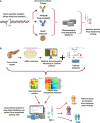Pathway-Based Drug-Repurposing Schemes in Cancer: The Role of Translational Bioinformatics
- PMID: 33520715
- PMCID: PMC7841291
- DOI: 10.3389/fonc.2020.605680
Pathway-Based Drug-Repurposing Schemes in Cancer: The Role of Translational Bioinformatics
Abstract
Cancer is a set of complex pathologies that has been recognized as a major public health problem worldwide for decades. A myriad of therapeutic strategies is indeed available. However, the wide variability in tumor physiology, response to therapy, added to multi-drug resistance poses enormous challenges in clinical oncology. The last years have witnessed a fast-paced development of novel experimental and translational approaches to therapeutics, that supplemented with computational and theoretical advances are opening promising avenues to cope with cancer defiances. At the core of these advances, there is a strong conceptual shift from gene-centric emphasis on driver mutations in specific oncogenes and tumor suppressors-let us call that the silver bullet approach to cancer therapeutics-to a systemic, semi-mechanistic approach based on pathway perturbations and global molecular and physiological regulatory patterns-we will call this the shrapnel approach. The silver bullet approach is still the best one to follow when clonal mutations in driver genes are present in the patient, and when there are targeted therapies to tackle those. Unfortunately, due to the heterogeneous nature of tumors this is not the common case. The wide molecular variability in the mutational level often is reduced to a much smaller set of pathway-based dysfunctions as evidenced by the well-known hallmarks of cancer. In such cases "shrapnel gunshots" may become more effective than "silver bullets". Here, we will briefly present both approaches and will abound on the discussion on the state of the art of pathway-based therapeutic designs from a translational bioinformatics and computational oncology perspective. Further development of these approaches depends on building collaborative, multidisciplinary teams to resort to the expertise of clinical oncologists, oncological surgeons, and molecular oncologists, but also of cancer cell biologists and pharmacologists, as well as bioinformaticians, computational biologists and data scientists. These teams will be capable of engaging on a cycle of analyzing high-throughput experiments, mining databases, researching on clinical data, validating the findings, and improving clinical outcomes for the benefits of the oncological patients.
Keywords: PharmaOncology; computational oncology; drug repurposing; pathway-based methods; translational bioinformatics.
Copyright © 2021 Hernández-Lemus and Martínez-García.
Conflict of interest statement
The authors declare that the research was conducted in the absence of any commercial or financial relationships that could be construed as a potential conflict of interest.
Figures

Similar articles
-
The future of Cochrane Neonatal.Early Hum Dev. 2020 Nov;150:105191. doi: 10.1016/j.earlhumdev.2020.105191. Epub 2020 Sep 12. Early Hum Dev. 2020. PMID: 33036834
-
Sepsis Care Pathway 2019.Qatar Med J. 2019 Nov 7;2019(2):4. doi: 10.5339/qmj.2019.qccc.4. eCollection 2019. Qatar Med J. 2019. PMID: 31763206 Free PMC article.
-
Computer-aided drug repurposing for cancer therapy: Approaches and opportunities to challenge anticancer targets.Semin Cancer Biol. 2021 Jan;68:59-74. doi: 10.1016/j.semcancer.2019.09.023. Epub 2019 Sep 25. Semin Cancer Biol. 2021. PMID: 31562957 Review.
-
The Minderoo-Monaco Commission on Plastics and Human Health.Ann Glob Health. 2023 Mar 21;89(1):23. doi: 10.5334/aogh.4056. eCollection 2023. Ann Glob Health. 2023. PMID: 36969097 Free PMC article. Review.
-
A primer on applying AI synergistically with domain expertise to oncology.Biochim Biophys Acta Rev Cancer. 2021 Aug;1876(1):188548. doi: 10.1016/j.bbcan.2021.188548. Epub 2021 Apr 24. Biochim Biophys Acta Rev Cancer. 2021. PMID: 33901609 Review.
Cited by
-
Emerging Signatures of Hematological Malignancies from Gene Expression and Transcription Factor-Gene Regulations.Int J Mol Sci. 2024 Dec 19;25(24):13588. doi: 10.3390/ijms252413588. Int J Mol Sci. 2024. PMID: 39769352 Free PMC article.
-
Pan-cancer analysis and oncogenic implications of MGAM and MGAM2: Toward precision oncology and drug repurposing in colorectal cancer.J Cell Commun Signal. 2025 Aug 27;19(3):e70042. doi: 10.1002/ccs3.70042. eCollection 2025 Sep. J Cell Commun Signal. 2025. PMID: 40881483 Free PMC article.
-
Drug repurposing-an emerging strategy in cancer therapeutics.Naunyn Schmiedebergs Arch Pharmacol. 2022 Oct;395(10):1139-1158. doi: 10.1007/s00210-022-02263-x. Epub 2022 Jun 13. Naunyn Schmiedebergs Arch Pharmacol. 2022. PMID: 35695911 Review.
-
Gene signatures to therapeutics: Assessing the potential of ivermectin against t(4;14) multiple myeloma.World J Clin Oncol. 2024 Jan 24;15(1):115-129. doi: 10.5306/wjco.v15.i1.115. World J Clin Oncol. 2024. PMID: 38292661 Free PMC article.
-
Integrative Analysis of Next-Generation Sequencing for Next-Generation Cancer Research toward Artificial Intelligence.Cancers (Basel). 2021 Jun 24;13(13):3148. doi: 10.3390/cancers13133148. Cancers (Basel). 2021. PMID: 34202427 Free PMC article. Review.
References
-
- Barratt MJ, Frail DE. Drug repositioning: Bringing new life to shelved assets and existing drugs. Hoboken, New Jersey: John Wiley & Sons; (2012).
Publication types
LinkOut - more resources
Full Text Sources
Other Literature Sources
Miscellaneous

